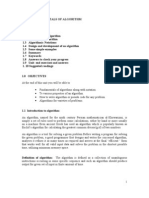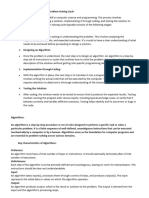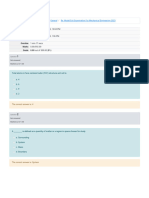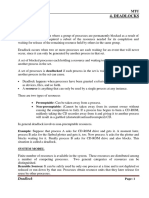How To Design Algorithm
Uploaded by
sirawdinkgetachew15How To Design Algorithm
Uploaded by
sirawdinkgetachew15Algorithm Design: A Step-by-Step Guide
Algorithm design is the process of creating a step-by-step procedure to solve a given problem.
It's a fundamental skill for programmers and computer scientists. Here's a general approach to
designing algorithms:
1. Understand the Problem:
● Define the problem clearly: What is the input, output, and desired outcome?
● Identify constraints: Are there any limitations on time, space, or resources?
● Break down the problem: Can it be divided into smaller, more manageable subproblems?
2. Develop a Solution:
● Choose a data structure: Select appropriate data structures (e.g., arrays, lists, dictionaries)
to represent the problem's data.
● Outline the steps: Write down the sequence of actions needed to solve the problem.
● Consider different approaches: Explore alternative algorithms or techniques.
3. Analyze the Solution:
● Correctness: Does the algorithm produce the correct output for all possible inputs?
● Efficiency: How does the algorithm perform in terms of time and space complexity?
● Clarity: Is the algorithm easy to understand and implement?
4. Implement the Algorithm:
● Choose a programming language: Select a suitable language (e.g., Python, Java, C++)
based on the problem and your preferences.
● Write the code: Translate the algorithm's steps into code.
● Test and debug: Thoroughly test the implementation to ensure it works as expected and
identify and fix any errors.
5. Refine and Optimize:
● Profile the code: Measure the algorithm's performance to identify bottlenecks.
● Optimize: Make changes to improve the algorithm's efficiency or clarity.
● Consider alternative approaches: Explore other algorithms that might be more suitable.
Example: Finding the Maximum Element in an Array
Problem: Given an array of numbers, find the largest number in the array.
Solution:
1. Initialize a variable max_value to the first element of the array.
2. Iterate through the remaining elements of the array.
3. If an element is greater than max_value, update max_value with that element.
4. After the loop, max_value will contain the maximum element.
Python implementation:
Python
def find_max(arr):
max_value = arr[0]
for num in arr[1:]:
if num > max_value:
max_value = num
return max_value
Remember: Algorithm design is an iterative process. You may need to refine and improve your
solution as you go. Practice and experience are key to becoming proficient in algorithm design.
You might also like
- DSA-Lect-4-Algorithms and pseudocode AnalysisNo ratings yetDSA-Lect-4-Algorithms and pseudocode Analysis14 pages
- An Algorithm - Characteristics and Types - Lecture-1No ratings yetAn Algorithm - Characteristics and Types - Lecture-18 pages
- Lecture Notes 1 On Analysis and Complexity of AlgorithmsNo ratings yetLecture Notes 1 On Analysis and Complexity of Algorithms29 pages
- COMP5070 - ExtraReading - From Problems To CodeNo ratings yetCOMP5070 - ExtraReading - From Problems To Code24 pages
- Basics of Data Structures and AlgorithmsNo ratings yetBasics of Data Structures and Algorithms64 pages
- Design Analysis and Algorithms: (Unit I Question Bank)No ratings yetDesign Analysis and Algorithms: (Unit I Question Bank)7 pages
- Algorithm Design Refers To A Method or A Mathematical Process For ProblemNo ratings yetAlgorithm Design Refers To A Method or A Mathematical Process For Problem3 pages
- Algorithm: Characteristics of An AlgorithmNo ratings yetAlgorithm: Characteristics of An Algorithm2 pages
- Lecture Fundamental Concept of Algorithm Introduction To Computer ScienceNo ratings yetLecture Fundamental Concept of Algorithm Introduction To Computer Science14 pages
- algorithms-and-complexity-analysis-csc304_1716907183No ratings yetalgorithms-and-complexity-analysis-csc304_171690718399 pages
- Introduction To Problem Solving and Programming Course Code: CSE 1021No ratings yetIntroduction To Problem Solving and Programming Course Code: CSE 102196 pages
- CSC 303 Analysis and Design of Algorithm-2No ratings yetCSC 303 Analysis and Design of Algorithm-243 pages
- PRACTICAL GUIDE TO LEARN ALGORITHMS: Master Algorithmic Problem-Solving Techniques (2024 Guide for Beginners)From EverandPRACTICAL GUIDE TO LEARN ALGORITHMS: Master Algorithmic Problem-Solving Techniques (2024 Guide for Beginners)No ratings yet
- Mechanical Engineering Short Note and Questions Based On Blue PrintNo ratings yetMechanical Engineering Short Note and Questions Based On Blue Print696 pages
- 565 Questions Model Exam For MechanicalNo ratings yet565 Questions Model Exam For Mechanical190 pages
- ClueFinders-Mystery-Mansion-Arcade Manual Win ENNo ratings yetClueFinders-Mystery-Mansion-Arcade Manual Win EN26 pages
- Software Design Document: Carpool SystemNo ratings yetSoftware Design Document: Carpool System48 pages
- Sicam Ak Sicam Ak 3 Sicam TM Sicam BC SM-2558/ETA4: Protocol Elements For Ethernet TCP/IPNo ratings yetSicam Ak Sicam Ak 3 Sicam TM Sicam BC SM-2558/ETA4: Protocol Elements For Ethernet TCP/IP16 pages
- 800xa Outline - Communications - S800 IO Communication InterfacesNo ratings yet800xa Outline - Communications - S800 IO Communication Interfaces7 pages
- Best Practices For Using Chrome Browser Cloud ManagementNo ratings yetBest Practices For Using Chrome Browser Cloud Management19 pages
- Reference: Apache Hadoop: Hadoop: The Definitive Guide, by Tom White, 2 Edition, Oreilly's, 2010100% (1)Reference: Apache Hadoop: Hadoop: The Definitive Guide, by Tom White, 2 Edition, Oreilly's, 201057 pages





























































































